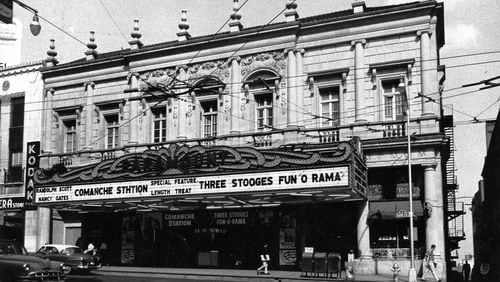Q: Several months ago, in a column about Elvis Presley’s appearances in Atlanta, you mentioned the Paramount Theatre. Where was the Paramount? How long was it around?
A: The Paramount, as its name suggests, was grand, and was one of several movie/music showplaces in downtown Atlanta throughout the mid-20th century.
The theater was called the Howard (after owner Troup Howard) when it opened on Peachtree Street ¬— near its intersection with Forsyth Street — in 1920 and was changed to Paramount in 1929.
Architect Philip Trammell Shutze (Swan House and many other Atlanta buildings and homes) designed the limestone exterior, which later included a marquee and sign with the theater’s name on it.
The Paramount was next to the Loew’s Grand, which was famous for holding the premiere of “Gone With the Wind” in 1939.
Presley played 10 shows at the Paramount in June 1956, but its run would soon come to an end.
The theater was demolished in 1960.
I’d love to hear your memories of the Paramount or questions about Atlanta’s old theaters. Give me a call or send an email.
Q: I’ve noticed the bridge where Jimmy Carter Boulevard crosses I-85 is named for someone. Who is that? How long has the bridge been dedicated for him?
A: The bridge is named for James Christopher "Chris" Magill, a Gwinnett County police officer who was killed in the line of duty on Interstate 85 in 1993.
He was in his car after making a traffic stop on I-85 when another vehicle driven by a drunk driver hit his car from behind.
Magill was from Gwinnett County and had been with the Gwinnett County Police Department for 10 years.
The bridge was dedicated in 2013 and includes “James C. ‘Chris’ Magill Memorial Bridge” signs that can be seen from I-85.
Loganville’s J.C. Magill Elementary, which opened in 1996, also is named for him.
Q: You’ve mentioned how several cities around the state were named, but I don’t think you’ve ever written about Morrow. Was there someone named Morrow? If so, what did he do?
A: I'm sure there have been many people named Morrow, but for our purposes, here are a couple of details about Radford E. Morrow.
Morrow was a plantation owner and the early town was known as Morrow Station, a railroad stop on the Macon & Western.
A post office was built in 1871 and the Clayton County city was incorporated in 1943.
Kenneth Krakow wrote in “Georgia Place-Names” that the city’s name originally was recorded as Marrow before being changed.
About the Author






